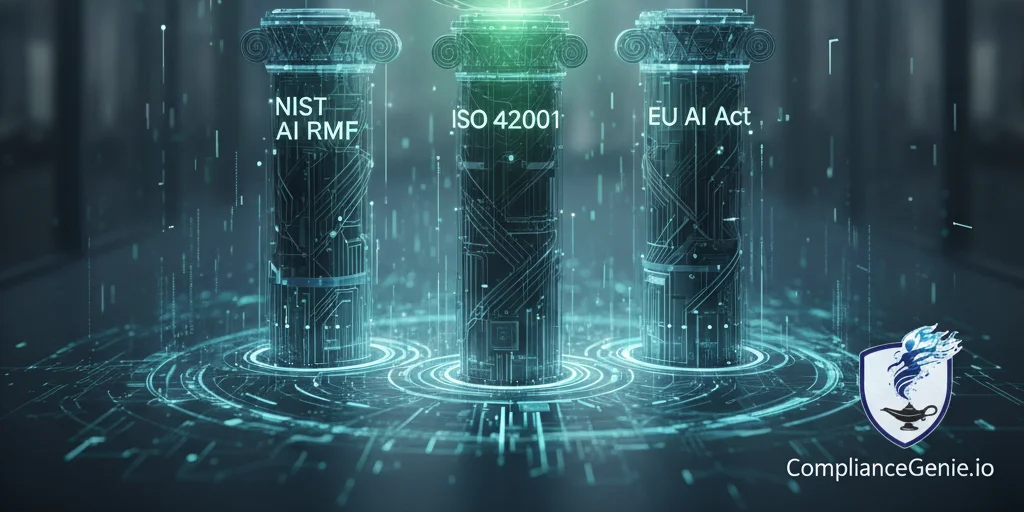
Frameworks That Matter: NIST AI RMF, ISO/IEC 42001:2023, and the EU AI Act
Frameworks That Matter: NIST AI RMF, ISO/IEC 42001:2023, and the EU AI Act
Introduction: Why Enterprises Can’t Ignore Frameworks Anymore
AI is no longer just a competitive differentiator—it’s a regulated asset. In 2024 and 2025, three governance frameworks emerged as cornerstones of enterprise AI compliance: the NIST AI Risk Management Framework (AI RMF), the ISO/IEC 42001 standard, and the EU AI Act.
Each offers a different lens: NIST AI RMF focuses on voluntary, trust-oriented risk management; ISO/IEC 42001 delivers a certifiable governance standard; and the EU AI Act enforces mandatory legal obligations. Together, they form the backbone of global AI governance.
For security and compliance leaders, the challenge isn’t choosing one but harmonizing them all.
NIST AI RMF: Flexible and Trust-Centered
The NIST AI Risk Management Framework (RMF), released in January 2023, provides a structured approach to managing AI risk.
- Four functions: Map, Measure, Manage, Govern.
- Focus areas: Trustworthiness principles like transparency, fairness, accountability, and security.
- Generative AI Profile (2024): Adds guidance on risks specific to foundation and large language models.
- Practical use: Often adopted by U.S. enterprises as a baseline for risk mapping and internal policy development.
Key strength: flexibility. The RMF is voluntary and adaptable across industries, making it a low-friction entry point for AI risk management.
ISO/IEC 42001: A Certifiable Governance Standard
Published in December 2023, ISO/IEC 42001 is the first certifiable international standard for AI governance.
- Management system approach: Structured like ISO/IEC 27001:2022, with a plan-do-check-act cycle.
- Requirements: AI risk assessments, lifecycle controls, accountability structures, monitoring, supplier oversight, and continual improvement.
- Ethics integration: Includes fairness, transparency, and accountability as governance pillars.
- Certification: Organizations can achieve ISO/IEC 42001:2023 certification to signal maturity and trustworthiness.
Example: Autodesk announced certification in 2025, tying it to its “Trusted AI” program—demonstrating how the standard translates into operational practices.
Key strength: assurance. Certification creates market and regulatory credibility, similar to how ISO/IEC 27001:2022 validates information security.
EU AI Act: The First Binding Global Regulation
Adopted in June 2024, the EU AI Act is the world’s first comprehensive AI law.
- Risk-based tiers: Unacceptable AI uses are banned; high-risk systems face strict obligations.
- High-risk requirements: Continuous risk management, quality training data, technical documentation, record-keeping, human oversight, and cybersecurity standards.
- Transparency mandates: Generative AI must disclose AI-generated content and summarize training data.
- Implementation timeline: Provisions phase in between 2025 and 2027, with high-risk requirements enforced after 36 months.
Key strength: enforceability. Non-compliance brings regulatory penalties and reputational risk, making EU alignment critical for global firms.
Comparison: Key Similarities and Differences
| Framework/Regulation | Scope | Strengths | Status |
|---|---|---|---|
| NIST AI RMF | Voluntary, U.S.-based, globally referenced | Flexibility, trust principles | Released Jan 2023; widely adopted |
| ISO/IEC 42001 | Global, certifiable standard | Assurance, lifecycle management | Published Dec 2023; certifications underway |
| EU AI Act | Binding law across EU market | Legal enforceability, high-risk obligations | Adopted Jun 2024; phased enforcement to 2027 |
Common threads: risk management, transparency, accountability, and human oversight. Differences lie in voluntary vs. certifiable vs. mandatory approaches.
Practical Alignment: Harmonizing Frameworks Without Duplicating Effort
Forward-looking enterprises aren’t choosing between frameworks—they’re integrating them:
- NIST RMF as an internal playbook for identifying and managing risks.
- ISO/IEC 42001:2023 as an auditable system of governance to assure regulators, partners, and customers.
- EU AI Act as the binding requirement that all EU-facing operations must meet.
Crosswalks help organizations map requirements between frameworks, reducing duplication. For example, ISO/IEC 42001:2023’s quality management requirements support EU AI Act compliance, while NIST RMF’s trustworthiness principles help guide internal controls.
Conclusion: Integrated Compliance Is Key
Enterprises that silo their compliance efforts risk wasted effort and governance gaps. The future of AI governance lies in harmonization: use NIST AI RMF for flexibility, ISO/IEC 42001 for certification, and the EU AI Act for legal alignment.
By weaving these frameworks together, organizations can build governance programs that are both resilient and credible. The result is not just compliance, but also trust—from boards, regulators, customers, and employees.
✅ Next in this series: We’ll move from frameworks to ethics—exploring how enterprises are turning Responsible AI principles into operational practice.
Open Source: This blog is powered by blog-engine, an open source repository.
Content Creation: This content was created with AI-assistance and reviewed by human experts to ensure accuracy and quality. We believe in transparent, human-in-the-loop AI content creation.